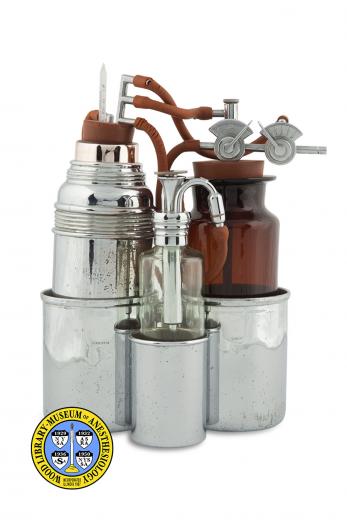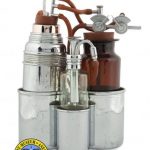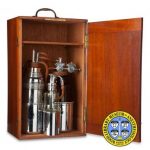Shipway Apparatus
The technique of endotracheal insufflation anesthesia was used in the first half the 20th Century. This delivered a continuous flow of anesthetic vapor through a tube inserted into the patient’s trachea (windpipe). As liquid anesthetics vaporize, the temperature of the surrounding air is lowered. At that time, it was thought that by warming the vapor inhaled by the patient, both induction and recovery would occur more rapidly, and thus less anesthetic would be needed.
The English physician, Sir Francis E. Shipway (1875-1968) was a leading anesthesia specialist. He believed that inhaling cold vapor caused patients to experience lung complications and falling body temperature during surgery. He introduced his warm vapor insufflation inhaler in 1916. It was used by the Royal Army Medical Corps in WWI, and was still available for military use in WWII. The apparatus includes a "Boyle Bottle" ether vaporizer (right) and a Junker chloroform vaporizer (front). Each is held in a warm water bath, and is connected to a vacuum flask (thermos) that holds hot water. A thermometer registers the temperature inside the flask. A hand pump was used to blow air first through the ether and/or chloroform vaporizers, and then through the vacuum flask on its way to the patient. Dr. Shipway and others attributed the improved results of this technique to the use of warmed vapor. This was later recognized as being due to his use of a long endotracheal tube.
Catalog Record: Shipway Apparatus
Access Key: akiq
Accession No.: 2005-06-26-1
Title: [Shipway’s apparatus, with extra regulating stopcock for oxygen / designed by Francis E. Shipway.]
Author: Shipway, Francis Edward, 1875-1968.
Title variation: Alt Title
Title: Shipway’s [apparatus] for warm ether and chloroform vapour.
Publisher: [London] : Down Bros., [1916-1945].
Physical Descript 1 vaporizer assembly : glass, metals, rubber ; 29 x 19.5 x 13 cm.
Subject: Vaporizers.
Subject: Chloroform.
Subject: Ether, Ethyl.
Subject: Anesthesia, Inhalation – instrumentation.
Subject: Insufflation.
Note Type: General
Notes: Title from a 1929 instrument catalog for the manufacturer, Down Bros., Ltd.
Because the main body of the apparatus may have been manufactured earlier
than the parts for regulating oxygen, 1916 was chosen as the early year in
the date range for the possible year of manufacture. The end year, 1945, is
based on the mention of the apparatus is some manufacturer catalogs into the
1940s. The date range could change if documentation indicates the range
should be corrected.
Note Type: With
Notes: Held in a wooden case that measures approximately 41 x 24.5 x 18 cm.; The
case is topped by a metal carrying handle; Inside the case is a wooden hook
made to steady the apparatus, and an upper shelf.
Note Type: Citation
Notes: A Catalogue of Surgical Instruments and Appliances with Appendix. London:
Down Bros., Ltd.; 1929:1343.
Note Type: Citation
Notes: Coe PA. Sir Francis Shipway (1875-1968): anaesthetist by royal appointment.
In: Atkinson RS, Boulton TB, eds. The History of Anaesthesia. Carnforth, UK:
Parthenon Publishing Group; 1989:559-564.
Note Type: Citation
Notes: Metcalfe NH. The effect of the First World War (1914-1918) on the development
of British anaesthesia. Eur J Anaesthesiol. 2007;24(8):649-657.
Note Type: Citation
Notes: Shipway FE. The advantages of warm anaesthetic vapours, and an apparatus for
their administration. Lancet. January 8, 1916;187(4819):70-74.
Note Type: Citation
Notes: Shipway FE. A criticism of some recent methods of anaesthesia. Br J Surg.
1913;1(1):96-113.
Note Type: Citation
Notes: Shipway FE. Intratracheal anaesthesia. Proc R Soc Med. 1914;7(sect
anaesth):31-34.
Note Type: Citation
Notes: Shipway FE. The intratracheal insufflation of ether. Br Med J. December 27,
1913;2(2765):1621-1623.
Note Type: Citation
Notes: Westhorpe CB. Insufflation anaesthesia and the Shipway apparatus. Anaesth
Intensive Care. 2013;41(3):287.
Note Type: Physical Description
Notes: A vaporizing apparatus composed of three bottles; The chloroform vaporizing
bottle is in front and is made of clear glass, the ether bottle is on the
right and made of amber glass, and the warming chamber is a bottle, or vacuum
flask, made of metal and glass; The chloroform bottle is the smallest and the
warming bottle is the largest; All three bottles sit in metal stands (called
jackets) that could hold the bottles in warm water; The chloroform bottle is
topped by a metal valve with two ports; Both of the warming bottle and ether
bottle are topped by red rubber corks, through which long tubes extend into
the bottles; The ports and regulating valves for regulating flow into the
chloroform and ether bottles, and or regulating oxygen are situated above the
ether bottle; Ports for directing and combing flow into the warming bottle
and to the patient are located above the warming bottle; A number of rubber
tubes connects the various ports; Also directed through the warming bottle is
a glass mercury thermometer; Embossed on the metal jacket for the warming
bottle are the letters, “DOWN BROS”.
Note Type: Reproduction
Notes: Photographed by Mr. Steve Donisch on January 17, 2013.
Note Type: Historical
Notes: Sometime after 1910, Sir Francis E. Shipway (1875-1968), an English
anesthesiologist, grew concerned over the progressive decrease in the
temperature of vaporized ether inhaled by patients during anesthesia. He
became convinced that inhaling cold vapors caused lung complications and
detrimental decreases in patient body temperature during surgery. He was also
interested in intratracheal ‘insufflation’ anesthesia, a relatively new
method that involved inserting a thin rubber tube down the throat and into
the trachea (windpipe). Vaporized ether, or chloroform, and air were then
continuously blown into the patient’s lungs via the tube. By 1914, using
equipment modified to meet his needs, Shipway had employed intratracheal
insufflation for 245 patients. He advocated for its many advantages over the
common open-drop technique. He also strongly urged fellow anesthesiologists
to warm anesthetic vapor before administering it to patients.
By 1916, with the help of a physiologist, Marcus S. Pembrey (1868-1934),
Shipway developed his own apparatus to produce warmed ether vapors. The
apparatus employed some parts from existing anesthesia devices and included
two vaporizing bottles; one for ether and one for chloroform. A control valve
allowed the anesthesiologist to direct air into one or both of the vaporizers
The vaporizer bottles were held in metal pans that contained warm water, and
the vapor was blown from the vaporizers through a third bottle, which
contained hot water (about 120 °F), before it reached the patient. Later in
1916, Shipway made a few improvements to his system. It was used at major
hospitals across Great Britain, as well as in military hospitals during World
War I.
During 1928, Shipway anesthetized King George V for two separate surgical
procedures involving the chest and was subsequently knighted in 1929.
Note Type: Exhibition
Notes: Chosen for the WLM website (noted July 30, 2013). Displayed in the gallery in
Park Ridge, on Northwest Highway, from 2005-2010.



